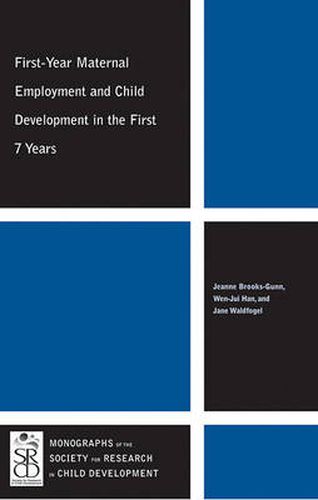Readings Newsletter
Become a Readings Member to make your shopping experience even easier.
Sign in or sign up for free!
You’re not far away from qualifying for FREE standard shipping within Australia
You’ve qualified for FREE standard shipping within Australia
The cart is loading…






Using data from the first 2 phases of the NICHD Study of Early Child Care, we examine the links between maternal employment in the first 12 months of life and cognitive, social, and emotional outcomes for children at age 3, at age 4 .5, and in first grade. Drawing on theory and prior research from developmental psychology as well as economics and sociology, we address 3 main questions. First, what associations exist between 1st year maternal employment and cognitive, social, and emotional outcomes for children in the first seven years of life? Second, to what extent do any such associations vary by the child’s gender and temperament or the mother’s occupation? Third, to what extent do mother’s earnings, the home environment (maternal depressive symptoms, sensitivity, and HOME scores), and the type and quality of child care mediate or offset any associations between 1st-year employment and child outcomes, and what is the net effect of 1st-year maternal employment once these factors are taken into account?
We compare families in which mothers worked full time (55%), part time (23%), or did not work (22%) in the first year. Our main results pertain to non-Hispanic White children (N = 900) although we also carry out some analyses for a small sample of African-American children (N = 113). Our findings provide new insight as to the net effects of 1st-year maternal employment as well as the potential pathways through which associations between 1st-year maternal employment and later child outcomes, where present, come about. Our structural equation modeling results indicate that, on average, the associations between 1st-year maternal employment and later cognitive, social, and emotional outcomes are neutral because negative effects, where present, are offset by positive effects. These results confirm that maternal employment in the 1st year of life may confer both advantages and disadvantages and that for the average non-Hispanic White child those effects balance each other.
$9.00 standard shipping within Australia
FREE standard shipping within Australia for orders over $100.00
Express & International shipping calculated at checkout
Using data from the first 2 phases of the NICHD Study of Early Child Care, we examine the links between maternal employment in the first 12 months of life and cognitive, social, and emotional outcomes for children at age 3, at age 4 .5, and in first grade. Drawing on theory and prior research from developmental psychology as well as economics and sociology, we address 3 main questions. First, what associations exist between 1st year maternal employment and cognitive, social, and emotional outcomes for children in the first seven years of life? Second, to what extent do any such associations vary by the child’s gender and temperament or the mother’s occupation? Third, to what extent do mother’s earnings, the home environment (maternal depressive symptoms, sensitivity, and HOME scores), and the type and quality of child care mediate or offset any associations between 1st-year employment and child outcomes, and what is the net effect of 1st-year maternal employment once these factors are taken into account?
We compare families in which mothers worked full time (55%), part time (23%), or did not work (22%) in the first year. Our main results pertain to non-Hispanic White children (N = 900) although we also carry out some analyses for a small sample of African-American children (N = 113). Our findings provide new insight as to the net effects of 1st-year maternal employment as well as the potential pathways through which associations between 1st-year maternal employment and later child outcomes, where present, come about. Our structural equation modeling results indicate that, on average, the associations between 1st-year maternal employment and later cognitive, social, and emotional outcomes are neutral because negative effects, where present, are offset by positive effects. These results confirm that maternal employment in the 1st year of life may confer both advantages and disadvantages and that for the average non-Hispanic White child those effects balance each other.